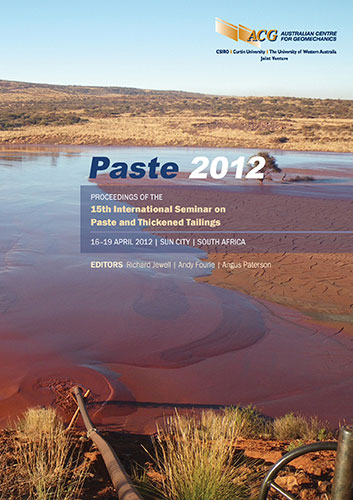Advanced diaphragm pumps with unique technical and commercial quality rating for operating pressures up to 500 bar

|
Authors: Nägel, HM Paper is not available for download Contact Us |
DOI https://doi.org/10.36487/ACG_rep/1263_26_Nagel
Cite As:
Nägel, HM 2012, 'Advanced diaphragm pumps with unique technical and commercial quality rating for operating pressures up to 500 bar', in R Jewell, AB Fourie & A Paterson (eds), Paste 2012: Proceedings of the 15th International Seminar on Paste and Thickened Tailings, Australian Centre for Geomechanics, Perth, pp. 309-323, https://doi.org/10.36487/ACG_rep/1263_26_Nagel
Abstract:
With traditional diaphragm piston pumps, wet end and drive end are separated by a circular flat diaphragm. The product is in contact with both the diaphragm and the pump casing. In the event of a diaphragm failure, the product, which is in many cases of an aggressive nature, penetrates and contaminates the hydraulic control area and causes considerable expense as well as unplanned and inconvenient pump downtime for cleaning and repair. In order to avoid the disadvantages of traditional diaphragm pumps, hermetically sealed hose-diaphragm piston pumps have been developed. With these pumps, the commonly utilised principle of a flat diaphragm has been extended by the additional provision of a flexible hose-diaphragm so that the conveyed fluid is in direct contact with the inside of the hose-diaphragm and check valves only. Although hose-diaphragm piston pumps already represent significant advantages over diaphragm pumps and have been well proven over a period of 40 years, consistent further development has been pursued with the hydraulically actuated double hose-diaphragm pump. With this advanced diaphragm pump, the flat diaphragm is fully abandoned. Double hose-diaphragm pumps are instead provided with a pair of tubular hose-diaphragms, which are arranged one inside the other. Unlike peristaltic hose pumps, double hose-diaphragms are not subject to mechanical squeezing, but actuated by the piston by means of a hydraulic fluid. They provide for smooth linear flow and unique redundant sealing between the wet and drive end. Even in the event that one of the hose-diaphragms fails, the second one ensures that the product neither comes into contact with the pump casing nor with the hydraulic drive area. The pump casing has no need to be manufactured from expensive special materials that are impervious to the slurry. Cylindrically shaped pump casings not only offer a considerably smaller footprint than circularly shaped flat diaphragm casings with a high number of bolts, but also ensure higher rigidity which allows for working pressures of up to 500 bar at excellent hydraulic efficiency. The small footprint of double hose-diaphragm pumps is particularly advantageous for underground mine applications. It allows for considerably reduced excavation costs. Cylindrical pump casings moreover allow for economical quintuplex pump configurations. These offer by far the highest efficiency and uniformity comparable with that of centrifugal pumps, which in turn contributes to a significant reduction of valve wear. Even without pulsation dampening, the irregularity of single-acting quintuplex reciprocating pumps is reduced to 5.1%, versus 23.0% of single-acting three cylinder pumps and 32.5% of single-acting four cylinder pumps. Redundancy of pulsation dampening equipment is all the more important as the negating of manually or automatically operated dampening devices is a great benefit as they are usually mandatorily employed when operating at variable discharge pressures.
References:
Hufnagel, G. (2010) Using Frequency Converter Drives to Power High-Performance Hose-Diaphragm Pumps, Pumps and compressors with compressed air and vacuum technology, Dr. Harnisch Verlag, Nürnberg, p. 114.
Nägel, H.M. (2010) Hermetically Sealed Displacement Pumps, The Evolution of Pump Technology, FELUWA Pumpen GmbH, pp. 113–115.
© Copyright 2025, Australian Centre for Geomechanics (ACG), The University of Western Australia. All rights reserved.
View copyright/legal information
Please direct any queries or error reports to repository-acg@uwa.edu.au
View copyright/legal information
Please direct any queries or error reports to repository-acg@uwa.edu.au